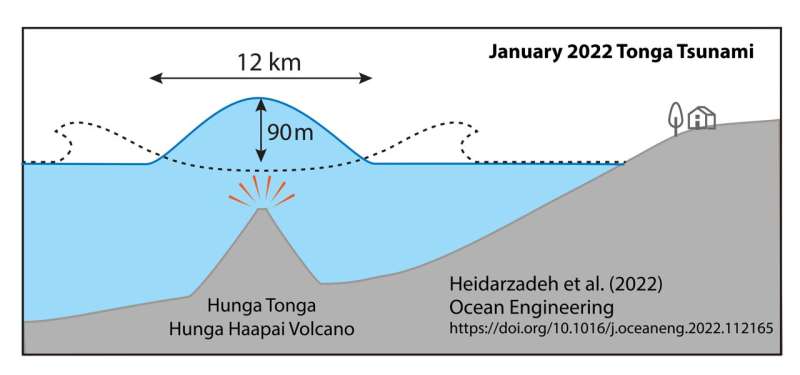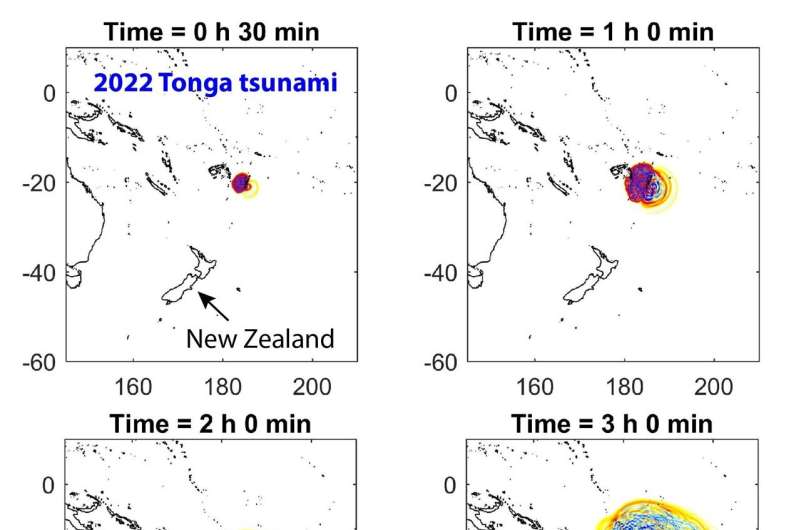Wave created by Tonga volcano eruption reached 90 meters—nine times taller than 2011 Japan tsunami

The initial tsunami wave created by the eruption of the underwater Hunga Tonga Ha’apai volcano in Tonga in January 2022 reached 90 meters in height, around nine times taller than that from the highly destructive 2011 Japan tsunami, new research has found.
An international research team says the eruption should serve as a wake-up call for international groups looking to protect people from similar events in future, claiming that detection and monitoring systems for volcano-based tsunamis are ’30 years behind’ comparable tools used to detect earthquake-based events.
Dr. Mohammad Heidarzadeh, Secretary-General of the International Tsunami Commission and a senior lecturer in the University of Bath’s Department of Architecture & Civil Engineering, authored the research alongside colleagues based in Japan, New Zealand, the UK and Croatia.
By comparison, the largest tsunami waves due to earthquakes before the Tonga event were recorded following the Tōhoku earthquake near Japan in 2011 and the 1960 Chilean earthquake, reached 10 meters in initial height. Those were more destructive as they happened closer to land, with waves that were wider.
Dr. Heidarzadeh says the Tonga tsunami should serve as a wake-up call for more preparedness and understanding of the causes and signs of tsunamis cause by volcanic eruptions. He says that “the Tongan tsunami tragically killed five people and caused large scale destruction, but its effects could have been even greater had the volcano been located closer to human communities. The volcano is located approximately 70 km from the Tongan capital Nuku’alofa—this distance significantly minimized its destructive power.”
“This was a gigantic, unique event and one that highlights that internationally we must invest in improving systems to detect volcanic tsunamis as these are currently around 30 years behind the systems we used to monitor for earthquakes. We are under-prepared for volcanic tsunamis.”
The research was carried out by analyzing ocean observation data recordings of atmospheric pressure changes and sea level oscillations, in combination with computer simulations validated with real-world data.

The research team found that the tsunami was unique as the waves were created not only by the water displaced by the volcano’s eruption, but also by huge atmospheric pressure waves, which circled around the globe multiple times. This ‘dual mechanism’ created a two-part tsunami—where initial ocean waves created by the atmospheric pressure waves were followed more than one hour later by a second surge created by the eruption’s water displacement.
This combination meant tsunami warning centers did not detect the initial wave as they are programmed to detect tsunamis based on water displacements rather than atmospheric pressure waves.
The research team also found that the January event was among very few tsunamis powerful enough to travel around the globe—it was recorded in all world’s oceans and large seas from Japan and the United States’ western seaboard in the North Pacific Ocean to the coasts within the Mediterranean Sea.
The paper, co-authored by colleagues from New Zealand’s GNS Science, the Association for the Development of Earthquake Prediction in Japan, the University of Split in Croatia and at London’s Brunel University, was published this week in Ocean Engineering.
Dr. Aditya Gusman, Tsunami Modeler at the New Zealand-based geoscience service, says that “the 2018 Anak Krakatau volcano and 2022 Hunga Tonga-Hunga Ha’apai volcano eruptions clearly showed us that coastal areas surrounding volcano islands are at risk of being hit by destructive tsunamis. Although it may be preferable to have low-lying coastal areas completely clear from residential buildings, such a policy may not be practical for some places as volcanic tsunamis can be considered infrequent events.”
Co-author Dr. Jadranka Šepić, from the University of Split, Croatia, adds that “what is important is to have efficient warning systems, which include both real-time warnings and education on what to do in a case of a tsunami or warning—such systems save lives. In addition, at volcanic areas, monitoring of volcanic activity should be organized, and more high-quality research into volcanic eruptions and areas at hazard is always a good idea.”
Separate research led by the University of Bath atmospheric physicist Dr. Corwin Wright published in June found that the Tonga eruption triggered atmospheric gravity waves that reached the edge of space.
Scientists provide explanation for exceptional Tonga tsunami
Mohammad Heidarzadeh et al, Estimating the eruption-induced water displacement source of the 15 January 2022 Tonga volcanic tsunami from tsunami spectra and numerical modelling, Ocean Engineering (2022). DOI: 10.1016/j.oceaneng.2022.112165
Citation:
Wave created by Tonga volcano eruption reached 90 meters—nine times taller than 2011 Japan tsunami (2022, August 19)
retrieved 19 August 2022
from https://phys.org/news/2022-08-tonga-volcano-eruption-metersnine-taller.html
This document is subject to copyright. Apart from any fair dealing for the purpose of private study or research, no
part may be reproduced without the written permission. The content is provided for information purposes only.
For all the latest Science News Click Here
For the latest news and updates, follow us on Google News.

